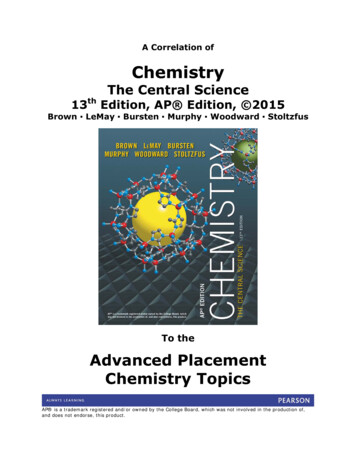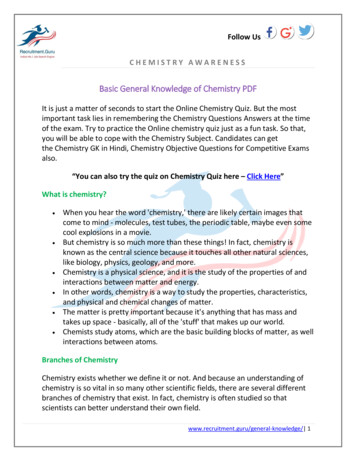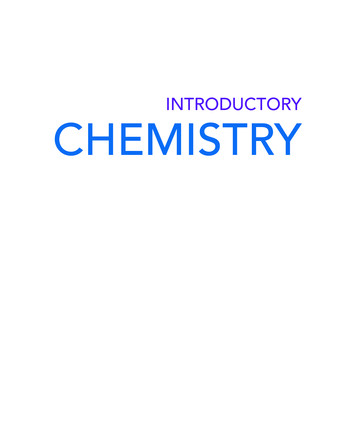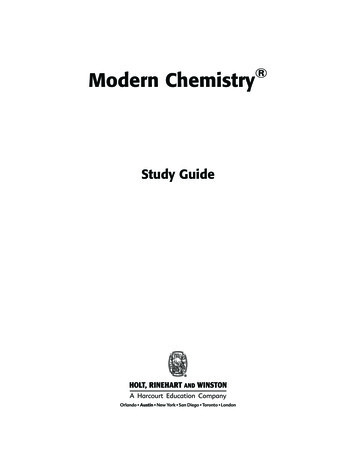
Transcription
A Correlation ofChemistryThe Central Science13th Edition, AP Edition, 2015Brown LeMay Bursten Murphy Woodward StoltzfusTo theAdvanced PlacementChemistry TopicsAP is a trademark registered and/or owned by the College Board, which was not involved in the production of,and does not endorse, this product.
xxivPrefaceAdvice for Learning andStudying ChemistryLearning chemistry requires both the assimilation of many concepts and the development of analytical skills. In this text, wehave provided you with numerous tools to help you succeed inboth tasks. If you are going to succeed in your chemistry course,you will have to develop good study habits. Science courses, andchemistry in particular, make different demands on your learning skills than do other types of courses. We offer the followingtips for success in your study of chemistry:Don’t fall behind! As the course moves along, new topics will build on material already presented. If you don’t keepup in your reading and problem solving, you will find it muchharder to follow the discussions on current topics. Experiencedteachers know that students who read the relevant sections ofthe text before coming to a class learn more from the class andretain greater recall. “Cramming” just before an exam has beenshown to be an ineffective way to study any subject, chemistry included. So now you know. How important to you, in thiscompetitive world, is a good grade in chemistry?Focus your study. The amount of information you will beexpected to learn can sometimes seem overwhelming. It is essential to recognize those concepts and skills that are particularlyimportant. Pay attention to what your teacher is emphasizing. Asyou work through the Sample Exercises and homework assignments, try to see what general principles and skills they employ.Use the What’s Ahead feature at the beginning of each chapter tohelp orient yourself to what is important in each chapter. A single reading of a chapter will simply not be enough for successfullearning of chapter concepts and problem-solving skills. You willneed to go over assigned materials more than once. Don’t skipthe Give It Some Thought and Go Figure features, Sample Exercises, and Practice Exercises. They are your guides to whetheryou are learning the material. They are also good preparationfor test-taking. The Learning Outcomes and Key Equations at theend of the chapter should help you focus your study.Keep good notes. Your notes will provide you with aclear and concise record of what your teacher regards as themost important material to learn. Using your lecture notes in conjunction with this text is the best way to determine whichmaterial to study.Skim topics in the text before they are covered in class.Reviewing a topic before class will make it easier for you to takegood notes. First read the What’s Ahead points and the endof-chapter Summary; then quickly read through the chapter,skipping Sample Exercises and supplemental sections. Payingattention to the titles of sections and subsections gives you afeeling for the scope of topics. Try to avoid thinking that youmust learn and understand everything right away.You need to do a certain amount of preparation beforeclass. More than ever, teachers are using the class period notsimply as a one-way channel of communication from teacherto student. Rather, they expect students to come to class readyto work on problem solving and critical thinking. Coming toclass unprepared is not a good idea for any environment, but itcertainly is not an option for an active learning classroom if youaim to do well in the course.A01 BROW0417 13 AP FM.indd 24After class, carefully read the topics covered in class. Asyou read, pay attention to the concepts presented and to the application of these concepts in the Sample Exercises. Once youthink you understand a Sample Exercise, test your understanding by working the accompanying Practice Exercise.Learn the language of chemistry. As you study chemistry, you will encounter many new words. It is important to payattention to these words and to know their meanings or theentities to which they refer. Knowing how to identify chemical substances from their names is an important skill; it canhelp you avoid painful mistakes on examinations. For example,“chlorine” and “chloride” refer to very different things.Attempt the assigned end-of-chapter exercises. Workingthe exercises selected by your teacher provides necessary practice in recalling and using the essential ideas of the chapter. Youcannot learn merely by observing; you must be a participant. Inparticular, try to resist checking the Student Solutions Manual(if you have one) until you have made a sincere effort to solvethe exercise yourself. If you get stuck on an exercise, however,get help from your teacher or another student. Spending morethan 20 minutes on a single exercise is rarely effective unlessyou know that it is particularly challenging.Learn to think like a scientist. This book is written by scientists who love chemistry. We encourage you to develop yourcritical thinking skills by taking advantage of new features inthis edition, such as exercises that focus on conceptual learning,and the Design an Experiment exercises.Use online resources. Some things are more easily learnedby discovery, and others are best shown in three dimensions.If your teacher has included MasteringChemistry with yourbook, take advantage of the unique tools it provides to get themost out of your time in chemistry.The bottom line is to work hard, study effectively, and usethe tools available to you, including this textbook. We wantto help you learn more about the world of chemistry and whychemistry is the central science. If you really learn chemistry,you can be the life of the party, impress your friends and parents, and well, also pass the course with a good grade.Tips for AP ChemistryExam SuccessEd Waterman, Rocky Mountain High SchoolThe Content and Nature of theAP Exam in ChemistryThe Advanced Placement Examination in Chemistry is a comprehensive evaluation of knowledge of all areas of generalchemistry at the first year college level. It consists of two equally90 minute sessions. Section I contains 60 multiple-choice questions worth 50% of the total score. Three long and fourshort free-response questions, counting for another 50%, compose Section II. Use of calculators is allowed only on the freeresponse section. A periodic table and a list of pertinent formulas and equations is available for the entire exam.11/7/13 7:08 PM
PrefacePearson Education also publishes Pearson Education TestPrep Workbook for AP Chemistry, a companion workbook toaccompany Chemistry: The Central Science, AP Edition. Thoroughly revised and redesigned, the 2015 Test Prep Workbookfor AP Chemistry correlates to the new AP Chemistry Curriculum Framework (CF) which launched in the 2013-2014 schoolyear. The test prep workbook contains concise content summaries of chapters that are relevant to the AP Chemistry Exam, testtaking tips, hundreds of multiple choice and free response practice questions, two complete practice exams with scoring guidelines, answers and detailed explanations of all questions. It alsopresents a review of spectroscopy, including mass spectrometry,photoelectron spectroscopy and UV-visible spectrophotometry.To order your own copy of the test prep workbook please visitPearsonschool.com/Advanced or call 1-800-848-9500.For more information and published examples of recentexams, please refer to the College Board’s Advanced Placementwebsite at http://apcentral.collegeboard.com/.Big Ideas and Learning ObjectivesThe AP Chemistry Curriculum Framework outlines the contentof the course around six Big Ideas and 117 learning objectives.The following outline identifies the important AP Chemistrycurriculum topics found in each chapter and section of this textorganized by the six Big Ideas. The tables that follow correlatethe 117 curriculum learning objectives to the pertinent chaptersand sections of Chemistry: The Central Science.Besides mastering content, students should be able to visualize and interpret atomic and molecular models, analyze datafor patterns and relationships, predict atomic and molecularproperties, justify their trends and select and perform chemicalcalculations for a variety of chemical systems.AP Chemistry Curriculum TopicsCorrelated to Chemistry: The CentralScience Table of ContentsBIG IDEA 1. All matter is composed of atoms. The contentfor Big Idea 1 is found primarily in Chapters 1, 2, 3, 6 and 7 ofChemistry: The Central Science.1. Introduction: Matter and Measurementxxv2.6 Molecules and Molecular Compounds. Molecules, chemical formulas, molecular formulas, empirical formulas, structural formulas.2.7 Ions and Ionic Compounds. Ion, cation, anion, polyatomicions, ionic charges, ionic compounds.3. Stoichiometry: Calculations with ChemicalFormulas and Equations3.3 Formula weights. Molar mass, percentage composition.3.4 Avogadro’s Number and the Mole. Moles, Avogadro’snumber, molar mass, interconverting mass, moles and numberof particles.3.5 Empirical Formulas from Analysis. Calculation of empirical and molecular formulas, combustion analysis.6. Electronic Structure of Atoms6.2 Quantized Energy and Photons. Quantum, photoelectriceffect.6.5 Quantum Mechanics and Atomic Orbitals. Quantum mechanical model, orbitals, electron shell, subshell.6.6 Representations of Orbitals. Shell model, orbitals designated s, p, d and f, relative energies, relative distance from thenucleus, probability distributions, electron density.6.8 Electron Configurations. Electron configuration, orbitaldiagram, core electrons, valence electrons.6.9 Electron Configurations and the Periodic Table. Representative elements, transition elements, f-block elements.7. Periodic Properties of the Elements7.2 Effective Nuclear Charge. Effective nuclear charge, screening effect, valence electrons, inner core electrons, trends in effective nuclear charge.7.3 Sizes of Ions. Atomic radius, ionic radius, trends in atomicand ionic radii, isoelectronic series.7.4 Ionization Energy. First ionization energy, successive ionization energies, trends in ionization energies, shells, subshellsand trends, electron configurations of ions.7.5 Electron Affinities Electron affinity as energy, trends,anomilies.7.6 Metals, Nonmetals and Metalloids. Metals, metallic character, metallic properties, nonmetals, nonmetal properties,metalloids, group trends.1.2 Classification of Matter. Gas, liquid, solid, pure substance,elements, symbols, compounds, mixtures.1.3 Properties of Matter. Physical properties, chemical properties, physical change, chemical change, separation of mixtures,filtration, distillation, chromatography.BIG IDEA 2. Bonding and intermolecular forces explain thephysical and chemical properties of matter. The content forBig Idea 2 is found primarily in Chapters 8, 9, 10, 11, 12 and 13of Chemistry: The Central Science.2. Atoms, Molecules and Ions8.1 Lewis Symbols and the Octet Rule. Lewis electron-dotsymbols, octet rule.8.2 Ionic Bonding. Electron transfer, lattice energy, Coulomb’slaw, s- and p-block electron configurations, transition metal ions8.3 Covalent Bonding. Lewis structures, multiple bonds.8.4 Bond Polarity and Electronegativity. Bond polarity, polarand nonpolar bonds, electron density, polar molecules, dipoles,differentiating covalent and ionic bonding.2.1 The Atomic Theory of Matter. Atoms, law of constantcomposition, law of conservation of mass, law of multiple proportions, Dalton’s atomic theory.2.3 The Modern View of Atomic Structure. Nucleus, electrons, structure of the atom, atomic mass unit, electrical chargesof subatomic particles, atomic number, mass number, isotopes,Coulomb’s law, mass spectrometry.A01 BROW0417 13 AP FM.indd 25Chapter 8. Basic Concepts of Chemical Bonding11/7/13 7:08 PM
xxviPreface8.5 Drawing Lewis Structures. Determining Lewis structures,formal charge.8.6 Resonance Structures. Resonance structures, delocalizedelectrons, depiction of resonance structures.8.7 Exceptions to the Octet Rule. Odd electrons, six electrons,expanded octets.8.8 Strengths of Covalent Bonds. Bond enthalpy, bond breaking, bond forming, calculations using bond enthalpies, bondlengths.9. Molecular Geometry and Bonding Theory9.1 Molecular Shapes. Linear, bent, trigonal planar, tetrahedral, trigonal pyramidal, bond angles.9.2 The VSEPR Model. Valence shell electron pair repulsion,bonding pair, electron domain, nonbonding pair, molecular geometry, electron domain geometry, expanded valence shells, Tshaped, trigonal bipyramidal, see-saw, octahedral.9.3 Molecular Shape and Polarity. Bond dipole, polar molecules, electron densities in molecules.9.5 Hybrid Orbitals. sp, sp2 and sp3 hybridization, orbital overlap, multiple bonds, s and p bonds, delocalized electrons.10. Gases10.2 Pressure. Standard atmospheric pressure, atmospheres, torr.10.3 The Gas Laws. Boyle’s law (pressure-volume), Charles law(temperature-volume), Boyles law and Charles law plots, absolute zero, Avogadro’s law.10.4 The Ideal-Gas Equation. Ideal gas, ideal-gas constant, calculations using ideal gas law.10.5 Further Applications of the Ideal-Gas Equation. Calculations of gas density, molar mass and volumes in chemical reactions.10.6 Gas Mixtures and Partial Pressures. Partial pressure, Dalton’s law, water vapor pressure.10.7 The Kinetic-Molecular Theory of Gases. Summary ofKMT, molecular collisions, molecular origin of gas properties,molecular speed distributions (Maxwell-Boltzmann), temperature as average kinetic energy.10.9 Real Gases: Deviations From Ideal Behavior. Real vs.ideal gases, effect of intermolecular forces, structure of particles.11. Liquids and Intermolecular Forces11.1 A Molecular Comparison of Gases, Liquids and Solids.Properties of the states of matter, particle explanations.11.2 Intermolecular Forces. Dispersion forces, polarizability,dipole-dipole forces, hydrogen bonding, ion-dipole forces, relative strengths of forces, explanation of molecular properties, solution formation.11.3 Select Properties of Liquids. Viscosity, surface tension,capillary action.11.4 Phase Changes. Energetics of phase changes, heat of fusion, heat of vaporization, heat of sublimation, heating curves,critical temperature and pressure.11.5 Vapor Pressure. Dynamic equilibrium, vapor pressure,volatility, distributions of kinetic energy, boiling point, vaporpressure plots.A01 BROW0417 13 AP FM.indd 2612. Solids and Modern Materials12.1 Classification of Solids. Metallic, ionic, covalent-networkand molecular solids, atomic and molecular explanations, polymers.12.2 Structures of Solids. Crystals, crystalline solids, amorphoussolids.12.3 Metallic Solids. Metallic solids, alloys, substitutional andinterstitial alloys.12.4 Metallic Bonding. Electron-sea model, delocalized electrons, thermal and electrical conductivity, malleability andductility.12.5 Ionic Solids. Ionic crystals, ionic interactions, atomic explanation of properties, brittleness, melting points, boiling points.12.6 Molecular Solids. Molecules, intermolecular forces, structural explanation of properties.12.7 Covalent-network solids. Diamond, graphite, semiconductors, doping, p-type, n-type, atomic explanations of properties.13. Properties of Solutions13.1 The Solution Process. Energetics of solution formation,spontaneous processes, entropy, effect of intermolecular forces,solva-tion, hydration, particle depictions.13.2 Saturated Solutions and Solubility. Crystallization, solubility, saturated, unsaturated, supersaturated.13.3 Factors Affecting Solubility. Miscible, immiscible, solutesolvent interactions, molecular structure, energetics, like dissolves like, pressure effects, temperature effects.13.4 Expressing Solution Concentration. Molarity, particleviews, calculations involving molarity.BIG IDEA 3. Chemical reactions involve the rearrangementof atoms and describe how matter changes. The content forBig Idea 3 is found primarily in Chapters 3, 4, 16 and 20 ofChemistry: The Central Science.Chapter 3. Stoichiometry: Calculations withChemical Formulas and Equations3.1 Chemical Equations. Chemical equations, reactants, products, balancing equations, coefficients.3.2. Some Simple Patterns of Chemical Reactivity. Combination (synthesis), decomposition, combustion.3.6. Quantitative Information from Balanced Equations.Stoichiometry, using equations to interconvert mass, moles andnumber of particles.3.7 Limiting Reactants. Limiting reatcatnt, theoretical yield,actual yield, percentage theoretical yield.Chapter 4. Reactions in Aqueous Solution4.1 General Properties of Aqueous Solutions. Molecules inwater, non-electrolytes, ions in solution, strong electrolytes,weak electrolytes, chemical equilibrium.4.2 Precipitation Reactions. Precipitate, solubility, solubilityguidelines, molecular (complete) equations, ionic equations,net ionic equations, spectator ions, writing net ionic equations.11/7/13 7:08 PM
Preface4.3 Acids, Bases, and Neutralization Reactions. Acids, protondonors, monoprotoc acids, diprotic acids, bases, proton acceptors, hydroxides, strong and weak acids and bases, strong acidsand bases as strong electrolytes, neutralization reactions, salts.4.4 Oxidation-Reduction Reactions. Oxidation, reduction,redox reactions, oxidation numbers, determining oxidationnumbers, displacement reactions, activity series.4.5 Concentrations of Solutions. Molarity, calculating molarity, interconverting molarity, moles and solution volume, dilution, preparing solution concentrations.4.6 Solution Stoichiometry and Chemical Analysis. Titration,standard solution, equivalence point, titration calculations,mass relations in a neutralization reaction.Chapter 5. Thermochemistry5.2 The First Law of Thermodynamics. Energy diagrams, exothermic and endothermic reactions, temperature change, energyfrom foods and fuels.Chapter 16. Acid-Base Equilibria16.2 Brønsted-Lowry Acids and BasesHydronium ion, proton transfer reactions, Brønsted-Lowryacid, Brønsted-Lowry base, conjugate acid-base pairs, relativestrengths of acids and basesChapter 20. Electrochemistry20.1 Oxidation States and Oxidation-Reduction ReactionsElectron transfer reactions, gain of electrons, loss of electrons20.2 Balancing Redox Equations Half reactions, half reactionmethod, redox titrations20.3 Voltaic Cells Voltaic (galvanic) cell, anode, cathode, saltbridge, direction of electron flow20.4 Cell Potentials Under Standard Conditions Cell potential, electromotive force, standard emf, standard reduction potential, standard hydrogen electrode, calculating cell potentials20.5 Free Energy and Redox Reactions Relationship of free energy ( G) to cell potential, Faraday’s constant, predicting thedirection of the reaction20.7 Batteries and Fuel Cells Electrical energy from batteries, lead-acid, alkaline, nickel-cadmium, nickel-metal-hydride,lithium-ion, hydrogen fuel cells20.9 Electrolysis Electrolytic cell, stoichiometry and redox reactions, calculating electrons transferred, mass, current, timeand charge, electrolysis of water, electroplatingBIG IDEA 4. Molecular collisions determine the rates ofchemical reactions. The content for Big Idea 4 is found primarilyin Chapter 14 of Chemistry: The Central Science.14. Chemical Kinetics14.1 Factors that Affect Reaction Rates. Effects of temperature, physical state, concentration and catalysts.14.2 Reaction Rates. Reaction rate as change in concentration per time, graphical representations of rate, rate and stoichiometry.A01 BROW0417 13 AP FM.indd 27xxvii14.3 Concentration and Rate Laws. Initial rate, spectroscopicmeasurement of rates, rate law, rate constant, reaction order,rate constant units, method of initial rate.14.4 The Change of Concentration with Time. Integrated ratelaw, zeroth, first and second order reactions, graphical representations, half-life, radioactive decay.14.5 Temperature and Rate. The collision model, orientationfactor, activation energy, activated complex, transition state,energy profile and reaction rate, graphical representations, Arrhenius equation (qualitative).14.6 Reaction Mechanisms. Mechanisms, elementary reaction,unimolecular, bimolecular and termolecular reactions, overallequation from elementary steps, intermediate, rate-determining step, mechanism and rate-determining step.14.7 Catalysis. Catalyst, homogeneous and heterogeneous catalysis, effect of catalyst on energy profile, surface catalyst, acid-basecatalysts, enzymes, active site, substrate, lock-and-key model.Big Idea 5. Thermodynamics describes the role energy playsin chemical and physical changes. The content in Big Idea 5 isfound primarily in Chapters 5 and 19 of Chemistry: The CentralScience.5. Thermochemistry5.1 The Nature of Energy. Energy, work, kinetic energy, potential energy, Coulomb’s law, electrostatic potential energy, measurement of energy, joules, calories, system, surroundings, force,work and heat.5.2 The First Law of Thermodynamics. Internal energy( E), relating E to work and heat, exothermic, endothermic.5.3 Enthalpy. Enthalpy, pressure-volume work (P V).5.4 Enthalpies of Reaction. Enthalpy of reaction ( H), thermochemical equation, enthalpy diagram, signs of H, relatingheats to stoichiometry5.5 Calorimetry. Constant pressure calorimetry, calorimeter,heat capacity, molar heat capacity, specific heat capacity, calculating heats.5.6 Hess’s Law. Heats added and subtracted like chemical equations.5.7 Enthalpies of Formation. Standard enthalpy of formation( Hf), formation reaction, using Hf to calculate enthalpies ofreaction, enthalpy diagrams.5.8 Foods and Fuels. Combustion of natural gas, fossil fuels, petroleum, coal, sugars and fats, renewable energy sources.19. Chemical Thermodynamics19.1 Spontaneous Processes. Spontaneous process, directionand extent of a reaction, reversible and irreversible processes.19.2 Entropy and the Second Law ofThermodynamics. Entropy (S), randomness, change in entropy ( S), S for phasechanges, second law of thermodynamics.19.3 Molecular Interpretation of Entropy. Translational, vibrational and rotational energy, entropy and phase, third law ofthermodynamics.11/7/13 7:08 PM
xxviiiPreface19.4 Entropy Change in Chemical Reactions. Standard molarentropies, entropy and temperature, molecular complexity.19.5 Gibbs Free Energy. Free energy ( G), free energy andequilibrium, G H - T S, standard free energy of formation.19.6 Free Energy and Temperature. Temperature and spontaneous processes, phase changes.19.7 Free Energy and the Equilibrium Constant. Standard andnonstandard conditions, relationship between G and K.BIG IDEA 6. Equilibrium represents a balance betweenenthalpy and entropy for reversible physical and chemical changes. The content for Big Idea 6 is found primarily inChapters 15, 16, and 17 of Chemistry: The Central Science.Chapter 15. Chemical Equilibrium15.1 The Concept of Equilibrium. Rates of forward and reversereactions, equilibrium mixtures.15.2 The Equilibrium Constant. Law of mass action, equilibrium constant expression, equilibrium constant (K), Kcand Kp.15.3 Understanding and Working with Equilibrium Constants.Magnitudes of K, chemical equations and K, stoichiometry andK, calculating K.15.4 Heterogeneous Equilibria. Homogeneous and heterogeneous equilibria and K.15.5 Calculating Equilibrium Constants. K from concentrations, K from initial conditions, ICE tables.15.6 Applications of Equilibrium Constants. Reaction quotient (Q), predicting direction, calculating concentrations.15.7 LeChâtelier’s Principle. LeChâtelier’s principle, changesin concentration, volume, pressure or temperature, catalysts,optimizing a product.Chapter 16. Acid-Base Equilibria16.2 Brønsted-Lowry Acids and Bases. Hydronium ion, proton transfer reactions, Brønsted-Lowry acids, Brønsted-Lowrybases, conjugate acid-base pairs, proton acceptor, proton donor,relative acid and base strengths.16.3 The Autoionization of Water. Ion-product constant (Kw),effect of temperature.16.4 The pH Scale. pH, pOH, measuring pH, indicators.16.5 Strong Acids and Bases. Complete ionization, c alculating pH.16.6 Weak Acids. Incomplete ionization, acid-dissociation constant (Ka), calculating concentration, Ka and pH, percent ionization, polyprotic acids.16.7 Weak Bases. Base-dissociation constant (Kb), amines asweak bases, calculating pH and pOH.16.8 Relationship Between Ka and Kb. KaKb Kw, K’s of conjugate acid-base pairs.16.9 Acid-Base Properties of Salt Solutions. Hydrolysis, anions as bases, cations as acids.16.10 Acid-Base Behavior and Chemical Structure. Factors that affect acid strength, oxidation number, electronegativity, oxyacids, carboxylic acids.17. Additional Aspects of Aqueous Equilibria17.1 The Common-Ion Effect. Common ions and equilibrium.17.2 Buffered Solutions. Buffers, buffer composition, bufferaction, buffer pH, buffer capacity, buffer calculations.17.3 Acid-base Titrations. Titration curve, pH of equivalencepoint, weak acid-strong base titrations, pKa of weak acid fromtitration data, polyprotic acid titrations, indicators.17.4 Solubility Equilibria. Solubility product constant (Ksp),solubility, calculating solubilities.17.5 Factors that Affect Solubility. Common ions, pH.Correlation Guide For APAP Chemistry Topics correlated to Chemistry: The Central Science, ThirteenthEdition, AP EditionBIG IDEA 1. All matter is composed of atoms.Learning ObjectiveScience PracticeChapter/Sectio1.1Use atomic molecular theory to explain that the element mass ratio in any purecompound is always identical.6.11.21.2Use mass data to quantitatively identify or infer the compositions of pure substances and mixtures.2.22.1, 2.41.3Use calculations of mass data to determine the identity or purity of a substance.2.2, 6.11.61.4Interconvert the number of particles, moles, mass, and volume of substances,both qualitatively and quantitatively.7.13.4A01 BROW0417 13 AP FM.indd 2811/7/13 7:08 PM
PrefaceLearning ObjectiveScience PracticexxixChapter/Sectio1.5Use data to explain electron distributions in atoms or ions.1.5, 6.26.8, 6.91.6Analyze data of electron energies for patterns and relationships.1.7Explain how energies of electrons vary within atomic shells using data fromphotoelectron spectroscopy, ionization energy data, and Coulomb’s law.5.16.8 TPWB5.1, 6.26.8 TPWB1.8Analyze measured energies and explain electron configurations using Coulomb’slaw.6.26.8 TPWB1.9Explain trends in atomic properties using the shell model or location on theperiodic table.6.47.2, 7.3, 7.41.10Use experimental evidence to explain the arrangement of the periodic table andapply periodic properties to chemical reactivity.6.17.6, 7.71.11Analyze and identify patterns in data of binary compounds to predict propertiesof related compounds.3.1, 5.18.2, 8.4 T8.1, T8.2,T8.31.12Explain how data sets support either the classical shell atomic model or thequantum mechanical model.6.36.2, 6.3, 6.4, 6.5, 6.65.32.1, 2.2, 2.3, 6.31.4, 1.52.41.13Determine if an atomic model is consistent with a given set of data.1.14Use mass spectral data to identify elements and isotopes.1.15Explain why various types of spectroscopy are used to measure vibrational andelectronic motions of molecules.4.11.16Design and interpret an experiment that uses spectrophotometry to determinethe concentration of a substance in a solution.4.2, 5.114.3, 4.5 TPWB1.17Use both symbols and particle drawings to quantitatively and qualitatively express the law of conservation of mass.1.53.11.18Apply conservation of atoms to particle views of balanced chemical reactionsand physical changes.1.43.1, 3.21.19Design or interpret data from a gravimetric analysis experiment to determinethe concentration of a substance in solution.4.2, 5.13.6, 3.71.20Design or interpret data from a titration experiment to determine the concentration of a substance in solution.4.2, 5.14.5, 4.6BIG IDEA 2. Bonding and intermolecular forces explain the physical and chemical properties of matter.Learning Objective2.1Predict and explain properties based on chemical formulas and particle views.2.2Explain the strengths of acids and bases using molecular structure, intermolecular forces, and solution equilibrium.2.3Science PracticeChapter/Section6.4, 7.18.2, 8.3, 8.47.216.2, 16.6, 16.9, 16.10Use particulate models to explain differences between solids and liquids.6.4, 7.111.1 to 11.72.4Use KMT and intermolecular forces to predict the macroscopic properties of realand ideal gases.1.4, 6.410.1, 10.2, 10.3, 10.7,10.92.5Use particle representations to explain the effect of changes in the macroscopicproperties of gases.1.3, 6.4, 7.210.3, 10.42.6Calculate temperature, pressure, volume and moles for an ideal gas.2.2, 2.310.3, 10.4, 10.5, 10.62.7Use intermolecular forces to explain how solutes separate by chromatography.2.8Draw and interpret particle representations of solutions showing interactions between the solute and solvent particles.6.213.3 TPWB1.1, 1.2, 6.413.1, 13.2, 13.32.9Create particle views of solutions to interpret molar concentration.1.1, 1.413.4, 13.5 VC 4.1–4.52.10Design an experiment to separate substances using filtration, paper chromatography, column chromatography, or distillation and explain how substances separate using intermolecular interactions.4.2, 5.113.3 TPWB2.11Use London dispersion forces to predict properties and explain trends for nonpolar substances.6.2, 6.411.2A01 BROW0417 13 AP FM.indd 2911/7/13 7:08 PM
xxxPrefaceLearning ObjectiveScience PracticeChapter/Section2.12Analyze data for real gases to identify deviations from ideal behavior and explainusing molecular interactions.5.1, 6.510.92.13Explain how the structural features of polar molecules affect the forces of attraction between them.1.4, 6.411.2, 13.32.14Using particle views, qualitatively apply Coulomb’s law to explain how the solubility of ionic compounds is affected by interactions of ions, and attractions between ions and solvents.1.4, 6.413.3 VC 13.1–13.122.15Explain the solubility of ionic
Prep Workbook for AP Chemistry, a companion workbook to accompany Chemistry: The Central Science, AP Edition. Thor-oughly revised and redesigned, the 2015 Test Prep Workbook for AP Chemistry correlates to the new AP Chemistry Curric-ulum Fr










